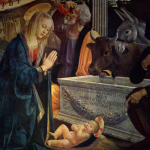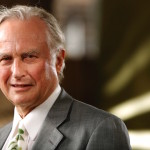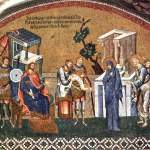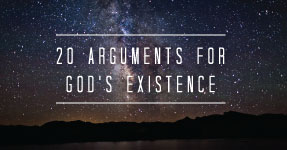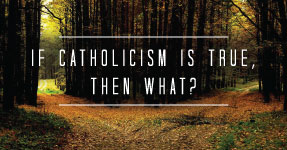Do the “Infancy Narratives” of Matthew and Luke Contradict Each Other?
by Tim Staples
Filed under Historicity, The Bible, The Incarnation
What do atheist skeptics and liberal Scripture scholars have in common? They both love to find alleged “contradictions” in Scripture. Though there are many of these alleged “contradictions,” one of the favorites of both of these camps is one that you can expect to find being re-hashed again and again on the Internet:—especially now that we are approaching Christmas—the “contradictions” found in what are commonly referred to as “the infancy narratives” of St. Matthew and St. Luke.
The late Fr. Raymond Brown, S.S., for example, who definitely made positive contributions to biblical study in the Church, also made some not-so-good contributions. In his book, The Birth of the Messiah, p. 46, for example, he flatly declares the two infancy narratives “are contrary to each other.”
Oy vey!
So What Gives?
The two “infancy narratives” are found in Luke 2:1-39 and Matthew 1:18-2:23. We’ll use St. Luke’s account as our beginning point of reference and from there we’ll move forward inserting the alleged “contradictions” as we go.
I’ll give you a very important pointer here at the outset for clarity’s sake: keep your eyes on the words I put in bold print as I lay out the narrative for St. Matthew and St. Luke's Gospels. These are the problem areas. And also keep in mind that these problems are not created by the texts of Scripture. They are created in the imaginations of those creating the so-called “contradictions.” Here we go:
According to St. Luke’s account, Mary and Joseph traveled from Nazareth to Bethlehem because of the census called for by Caesar Augustus. It would be there that Mary “gave birth to her first-born son and wrapped him in swaddling clothes, and laid him in a manger…” (2:1-7) Are we good, so far?
Well, maybe not!
According to St. Matthew’s Gospel, there is no account of a journey from Nazareth to Bethlehem. And this is true. But skeptics claim St. Matthew portrays the Holy Family to have been living in Bethlehem, not Nazareth. There would have been no way for there to have even been a journey to Bethlehem if Matthew’s scenario were true. The Holy Family was already there!
Moreover, Jesus is not found in St. Luke’s “manger,” but Matthew 2:11 says the Wise Men found him in a “house” in Bethlehem where the Holy Family was not staying in the Inn—or more precisely, the manger attached to an Inn—that we find in Luke’s Gospel. In Matthew’s Gospel, Jesus is depicted as being born in the family home of Mary and Joseph in Bethlehem where they had lived all along, contradicting St. Luke’s account. Herein we find the first of these narratives’ supposed irreconcilable contradictions.
A Biblical Response:
There are two crucial assumptions made here that have nothing to do with the actual text of Scripture.
1. Because there is “no account of a journey from Nazareth to Bethlehem” in St. Matthew’s Gospel, this does not mean St. Matthew’s Gospel excludes it as a possibility. It doesn’t. It just means St. Matthew chose not to mention it.
2. And this is the most crucial error that, when understood properly, will end up dispelling most of the misconstrued contradictions we find out and about in cyberspace. The assumption is made that St. Matthew’s recording of the Wise Men following the star leads them to the Holy Family at the time of Jesus’ actual birth, and in Bethlehem. But the text does not actually say this.
Let me explain.
First, let’s look at Matthew 2:1:
"Now when Jesus was born in Bethlehem of Judea in the days of Herod the king, behold, Wise Men from the East came to Jerusalem…"
Critics nearly unanimously interpret this to mean that St. Matthew is claiming the Wise Men arrived in Bethlehem at the time Christ was born. The truth is: it doesn’t say that. It simply says Christ was born during the days of King Herod and that the Wise Men came in those days to see—as they themselves asked upon their arrival in Jerusalem—where they could find “he who has been born king of the Jews” (Matt. 2:2).Matthew 2:1-2 does not specify how much time had transpired since the actual birth of Jesus.
However, having said that, though Matthew 2:1-2 doesn’t specify the time of Christ’s birth, we do have clues elsewhere that indicate the Wise Men did not arrive at the time Christ was actually born; rather, one to as much as two years later.
Little Drummer Boy History
I know what you’re thinking. Or, at least, what you should be thinking. I love “The Little Drummer Boy,” too! (Yes, that was said “tongue and cheek,” folks!) My family and I watch it every year at Christmas! And multiple times (we have the DVD).
(It's great having young children in the house. It gives me an excuse to watch all those kid-oriented Christmas specials!)
But unfortunately, “The Little Drummer Boy,” as well as a whole slew of atheists and liberal theologians, has his (and their) time-line all wrong here. Perhaps there is a lesson here about getting one’s theology, or history, through children’s Claymation television shows?
At any rate, the Nativity is commonly portrayed with Magi, Shepherds, and yes, maybe even the little drummer boy, all together at the manger with the Holy Family and the new-born baby Jesus. But that is not the way the Bible portrays it.
First of all, when the Magi “saw his star” in the East that indicated the birth of the “king of the Jews,” it was only then that they began their journey to Israel, according to Matthew 2:2. And remember, this was before you could jump on a commuter jet. Coming from Persia, most likely, they would have had to travel around 970 miles to get to Jerusalem. At least, that’s the distance from modern Tehran, anyway. Even if you move eastward as far as modern Bagdad as their starting point, they would have still had to travel at least 500 miles.
Why is this significant?
Matthew 2:3-7 tells us that after the Wise Men arrived in Jerusalem and began asking about the location of “he who has been born king of the Jews” (notice, they did not say “new-born king” as many assume, they said, “he who has been born king of the Jews…”), Herod was troubled, for obvious reasons. He was corrupt and didn’t want another “king” to threaten his position of power. So, after “assembling all of the chief priests, and scribes” (v. 4), and asking them where the Messiah was to be born, they informed him of Micah’s prophecy (Micah 5:2) that foretold Bethlehem as the birthplace of the coming king. Herod then decided to pretend he was interested in welcoming, and worshipping, this new “king of Israel” just as the Magi were. He really wanted to find out precisely where this king was located, so he could eliminate the threat… permanently.
But notice what Matthew 2:7 says:
"Then Herod summoned the Wise Men secretly and ascertained from them what time the star appeared, and he sent them to Bethlehem, saying, “Go and search diligently for the child, and when you have found him bring me word, that I too may come and worship him.”"
Herod wanted to know “when the star appeared” so he could know the approximate age of the child. This indicates that the star appeared to the Magi when Jesus was born, before their journey to Israel. This eliminates the possibility of the Magi meeting the shepherds and the Holy Family at the manger.
Moreover, after God warned the Magi “not to return to Herod” in Matthew 2:12, and Herod later realizes they were not coming back to give him his desired information about the location of Jesus, in 2:16, “in a rage” he determined to “kill all of the children in Bethlehem and in all that region who were two years old or under, according to the time which he had ascertained from the Wise Men" (emphasis added).
Thus, if we allow for Herod hedging his bet to make sure he kills the right child, the information he garnered from the Magi would probably have placed the birth of Christ at about a year or so before the Magi’s arrival. Herod would probably want a cushion on each side of the approximate time of Christ’s birth.
Most importantly, this would indicate Christ would have been 1 to at most 2 years-old (though I would again say it would be unlikely Christ would have been a full two years-old) at the time the Wise Men arrived in Jerusalem to find the Christ-child. This would have been 1 to 2 years after the nativity of St. Luke’s Gospel.
Many will say at this point that a journey of 500 to 1,000 miles would not take that long. If you say the caravan of the Wise Men could travel about 5 to 10 miles per day, it would have taken anywhere from two to seven months of travel. This is true, but this does not take into account many variables. You didn’t just jump into a car or airplane and go. It would have taken time to plan the trip, gather supplies, security, etc. These and more contingencies are simply not revealed to us in the text. But we do get hints here about what Herod concluded from his personal interview of the Magi themselves. The text of Scripture indicates it was the Magi that revealed the time of Christ's birth to have been long before the Magi's arrival in Nazareth.
Check Your Assumptions at the Door
Once we get the above timeline right, the “contradictions” between “infancy narratives” are not so contradictory any longer. We are not going to get to all of the “contradictions” claimed, but as one other example, the claim is also made that when the Wise Men were sent to Bethlehem by Herod, then that would naturally have been where they ended up finding the Holy Family when they arrive at the place “where the child was” in Matthew 2:9. This is the foundation for the “contradiction” between St. Luke’s “manger” and St. Matthew’s “house,” and more. The problem is: the text doesn’t say the Wise Men actually found the Christ-child in Bethlehem. This is another non-biblical assumption.
In fact, Matthew 2:9 tells us that after Herod ordered the Magi to go to Bethlehem, it would be the miraculous star that would actually guide them to Christ. The text doesn’t explicitly say this, but we can reasonably assume the star would not lead them to the wrong location! If the Wise Men would have then headed to Bethlehem, the Holy Family would have been long gone. The star would have led them to Nazareth, where, St. Luke tells us, in 2:39, “[the Holy Family] returned,” but only after “they had performed everything according to the law of the Lord.”
Back to St. Luke’s Gospel
It is crucial to understand that other than the mention of Christ’s actual birth in Matthew 2:1, there is no overlap with Luke’s infancy narrative and Matthew’s. Here’s a time-line:
Matthew 2:1 mentions Christ’s actual birth in Bethlehem. This sole overlap parallels Luke 2:6-7.
But because we know St. Matthew’s Gospel then leaps forward to the story of the Magi, one to at most two years after Christ’s birth, the story of the shepherd and the angels finding Christ in Bethlehem in Luke 2:8-20, the circumcision of Christ while the Holy Family was still in Bethlehem in Luke 2:21, the “Presentation of the Lord” in the temple of Luke 2:22-36 (a six-mile trip that would take the better part of a day to walk), and the “return to Nazareth” of Luke 2:39, all happen within about 40 or so days after Christ’s birth, and long before the Magi arrive at Nazareth in search of the “king of Israel.”
With this in mind, we can now eliminate the above-mentioned “contradictions” quite easily:
1. The “home” in Matthew 2:11 does not conflict with the “manger” in Luke 2:7. The “home” was in Nazareth where the Holy Family had traveled well over a year before the coming of the Magi.
2. Matthew’s Gospel never actually says the “home” mentioned in 2:11 was in Bethlehem.
3. The Wise Men were “sent” to Bethlehem by Herod, but the text never says that is where they ended up. We know, in fact, they would have ended up in Nazareth where Christ actually was, not Bethlehem.
Another Assumption Exploded
As I said above, in this brief post, we are not going to eliminate all of the errors that are out there claiming contradictions between the infancy narratives. In fact, there are some who argue for contradictions even within the narratives themselves. But if you keep in mind the historical timeline laid out here, you can deal with most of the claimed anomalies.
Here is one final example:
Matthew 2:23 tells us the Holy Family never went to live in Nazareth until after the coming of the Magi and the flight into Egypt. It was only then, the text says, “[Joseph and the Holy Family] went and dwelt in a city called Nazareth.” Yet, St. Luke says, it was after the 40 days of purification after the birth of Christ that “[the Holy Family] returned into Galilee, to… Nazareth.”
Actually, Matthew 2:23 does not say the Holy Family “first” went to Nazareth after the flight into Egypt. That is another unbiblical assumption. After being warned by God to flee Herod’s wrath and travel to Egypt in Matthew 2:13-14, and then after being told by an angel of the Lord to return to Israel, in Matthew 2:20, it appears St. Joseph’s desire was to go back to his family’s native Bethlehem in Judea, but because Herod’s son, Archela’us, was reigning there, “he was afraid to go there, and being warned in a dream” he went to Nazareth instead (Matthew 2:22-23).
We have to remember that the inspired authors place emphases on particular aspects of the life of Christ and the Holy Family for particular theological reasons. St. Matthew is writing to a Jewish Christian community; thus, he emphasizes both Christ’s birth in Bethlehem to fulfill the Old Testament prophecy of Micah 5:2 (Matthew 2:5-6), and the fulfillment of the Oral Tradition, or word “spoken by the prophets,” that Christ would be “called a Nazarene” (Matthew 2:23). St. Luke, the only inspired Evangelist who was also a Gentile, did not seem as interested in pointing those things out.
For St. Matthew’s purpose, it would not suffice for him to simply mention Jesus' brief sojourn in Bethlehem as an infant and toddler; he had to be raised in Nazareth in order to be “called a Nazarene.” Thus, the emphasis of St. Matthew is on Christ and the Holy Family coming to Nazareth where Christ would be raised in order to fulfill the prophecy “spoken by the prophets” (Matthew 2:23). But he never says this was the “first” time they had been there.
Final Thought
There is much more to be done here—multiple alleged “contradictions” to clear up. But to do that, we must establish a true context for Scripture free from assumptions that don’t jive with the entirety of the text.
Related Posts
Note: Our goal is to cultivate serious and respectful dialogue. While it's OK to disagree—even encouraged!—any snarky, offensive, or off-topic comments will be deleted. Before commenting please read the Commenting Rules and Tips. If you're having trouble commenting, read the Commenting Instructions.





